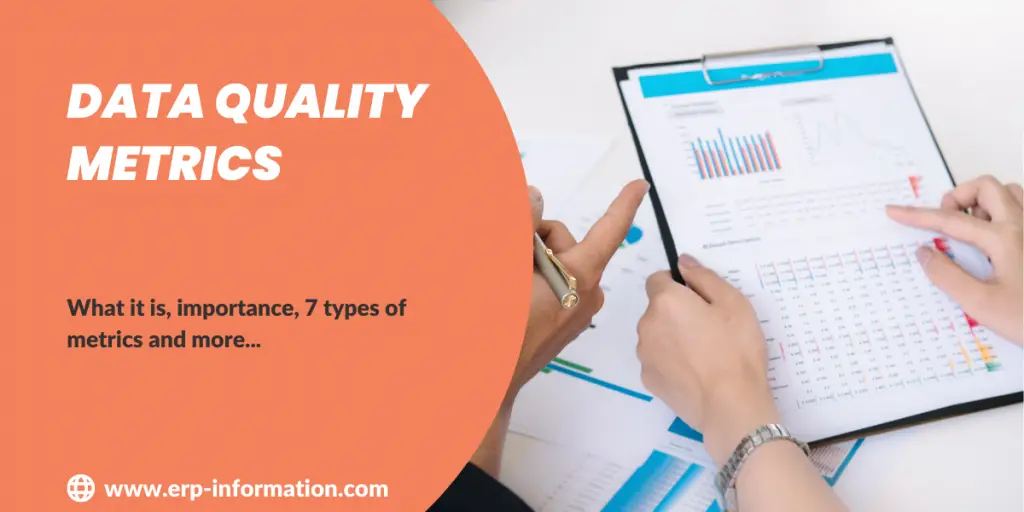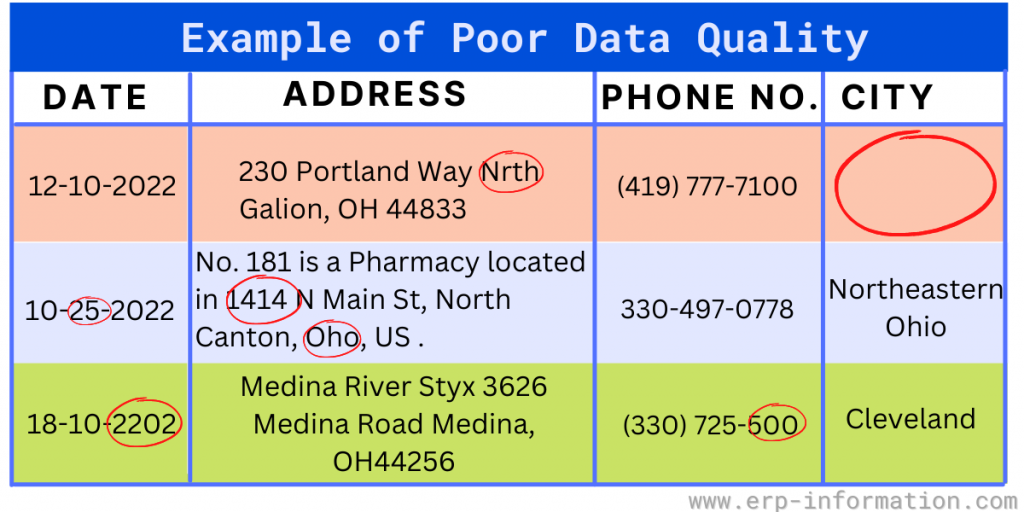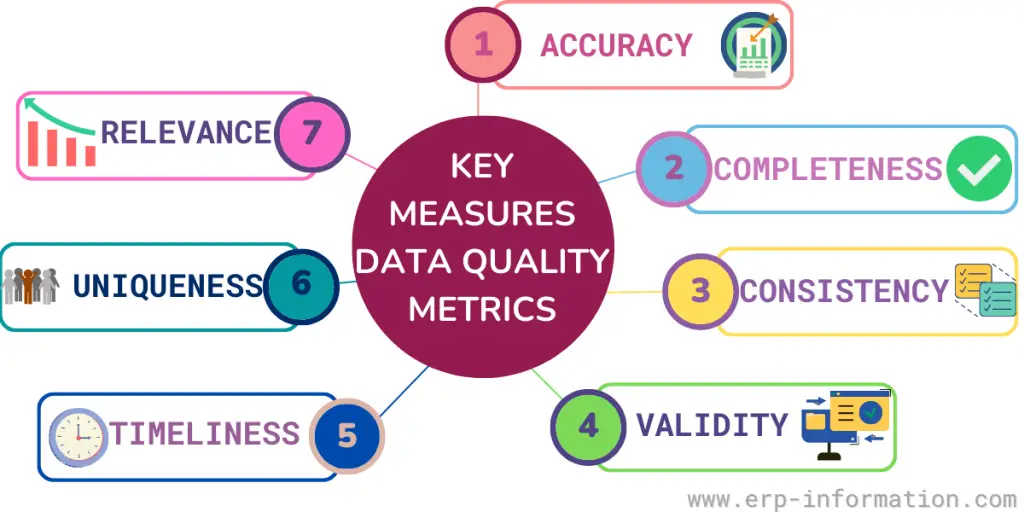Data quality is a critical aspect of any business. If your data is accurate, you will make good decisions to help your bottom line. That’s why it’s important to track data quality metrics.
In this post, we will discuss 7 essential data quality metrics that you need to track. We will also provide examples of these metrics and what they mean for your business.
What are data quality metrics?
Data quality metrics are measures used to quantify data quality, often concerning its accuracy, completeness, and other parameters. Data quality metrics help organizations assess the value of their data and determine whether it meets their needs.
The below image shows an example of poor data entry. It shows inaccurate, incomplete data entry.
Why are data quality metrics important to business?
Data quality metrics are essential to businesses for a multitude of reasons. First and foremost, data quality metrics enable organizations to measure their data’s accuracy, completeness, and consistency.
It is critical because companies cannot trust their use without understanding the data’s integrity. For example, if a company uses data from customer surveys to make decisions, it can only do so confidently if they know that the data is accurate.
Furthermore, quality metrics enable companies to monitor their performance over time and identify potential issues with their data collection process. This ensures that errors or omissions are addressed quickly and prevents them from becoming major problems.
Lastly, data quality metrics can also inform the development of data-driven solutions, allowing businesses to make more informed decisions based on insights gained from their data.
What are essential data quality metrics that you need to track?
When it comes to data quality metrics, there are seven key measures that you need to track:
1. Accuracy
Data quality metrics look at how accurately data capture reality. It is important to ensure data is accurate, so businesses make decisions based on facts rather than assumptions. Data accuracy measures the degree of correctness and precision of values within a dataset.
In addition, it evaluates how closely an individual data point matches its expected or true value. This metric is important for ensuring data integrity, as incorrect data can lead to wrong decisions.
You can use different metrics to measure how accurate your data is. One example is the percentage of incorrect data. Another example is the difference between the expected value and the actual value.
You can also look at how close the data is to a target value. These are just a few examples, so many other ways to measure accuracy exist.
2. Completeness
This metric measures how much of the data set are complete. That means whether all the relevant information has been captured or not. In addition, it assesses whether all of the necessary fields are populated with valid values and, if not, why they may be missing.
You can measure this by looking at missing values in the data set. It’s important to ensure all data points are present for it to be useful for decision-making.
3. Consistency
This metric looks at how consistent the data is across different sources. It’s essential to have consistent data for it to be useful for decision-making.
4. Validity
This metric looks at the validity of the data or whether it meets certain requirements before being used. It’s important to ensure your data meets certain criteria before using it.
5. Timeliness
This metric measures how current the data is or how quickly it can be used to make decisions. Timeliness measures how up-to-date a dataset is and the speed at which changes to the data get reflected in your systems.
An outdated or delayed dataset could affect operational efficiency and decision-making based on incorrect information.
6. Uniqueness
This metric looks at how unique the data is. It’s important to ensure your data is not duplicated or redundant, as this can lead to inaccurate insights.
7. Relevance
This metric assesses how relevant the data is to your business. It looks at whether the data is useful for decision-making and whether it aligns with current trends.
What are the things that you can do to improve the data quality?
Any business must improve data quality to achieve operational efficiency and stay competitive.
There are a variety of data quality metrics, measures, and examples that can help organizations measure the accuracy and completeness of their data. We listed12 things that you can do to improve the quality of your data:
Data assessment
Before improving data quality, you need to find out what type of data you collect, where to store it, who can access it, and how to use it.
Establish a data quality standard
Set a baseline for data quality and ensure that all data is up to the standard. That will help you more easily identify areas for improvement.
Monitor data integrity
Make sure that data is valid, accurate, and complete using automated validation rules and checksums.
Remove data silos
Use a data warehouse to combine all your data sources into one centralized location.
Establish data governance
Establishing a data governance framework is key to ensuring that data quality is maintained. That includes defining roles and responsibilities, establishing policies and procedures, and monitoring compliance.
Clearly define a common data format
Define the data format for entry which should be clear and consistent. Data entry errors are often the result of users entering freeform data.
For example, if you allow users to enter a date manually, some might enter in the form of “dd/mm/yy, “while others could enter in the form of “mm/dd/yy.” All of these variants would lead to significant data inconsistencies and errors. To avoid this problem, only offer users-defined list values or options for common fields.
Regular data audits
Conduct regular data audits to ensure that it meets the defined standards. That should include reviewing the completeness, accuracy, timeliness, and data consistency.
Invest in data quality tools
Utilize tools such as data cleansing (For example, ETL – extract, transform, and load)to ensure that your data is accurate and up-to-date.
It processes to clean up any outdated or inconsistent data by removing unnecessary duplicates or filling in missing values. Automating the process can help save time and effort.
Utilize data profiling
Data profiling can help you quickly identify data issues such as duplication and missing values.
Monitor metrics
Track key performance metrics regularly to ensure that your data is accurate and up-to-date.
Invest in training
Educate staff on data quality concepts, methods, and processes to ensure they can identify and fix data quality issues.
Establish a good data quality management system
Set up a data quality management system that includes policies, processes, and procedures to ensure the data is accurate. This system should include monitoring, feedback loops for data improvement, and internal checks and balances.
By following these tips, businesses can improve the accuracy and completeness of their data and increase operational efficiency. In addition, improving the quality of your data helps you better understand your customers and make more informed decisions.
When data quality is improved, businesses can save time and make profits in the long run while making sure they are relying on accurate information to inform their decisions. Therefore, companies need to monitor, evaluate, and improve the quality of their data.
What are the impacts of poor data on business?
The impacts of poor data on business can be far-reaching and devastating. Insufficient data can lead to various problems, ranging from financial losses due to inaccurate information to losses in customer loyalty due to unreliable services.
Poor data quality can also lead to a decline in business efficiency, as incorrect or incomplete data can slow down processes and increase costs.
Waste of resources
Poor data quality can result in wasted resources on inaccurate or redundant processes. That can lead to an overall decrease in efficiency and costs.
Bad customer experience
Poorly sourced, incomplete, or unreliable data can lead to a bad customer experience. That could result in customers losing trust in the company and going elsewhere for their needs.
Inaccurate decisions
Poor data quality can lead to bad decision-making due to inaccurate results from the analysis. That can put the business at risk of missing opportunities, failing to solve problems, or making bad investments.
Reduces reputation
Poor data quality can lead to a company’s reputation loss, as customers and other businesses may not trust their data. That can lead to further losses due to a lack of confidence in their services.
Obstruct regulatory compliance
Poor data quality can also lead to compliance issues, as the data may need to meet regulatory requirements. That can result in hefty fines or penalties for the business, especially if they fail to address the issue.
Fulfillment delays
Poor data quality can lead to fulfillment delays, as inaccurate or incomplete data can slow down the process. That could also lead to additional costs and customer dissatisfaction.
It is essential to measure data quality using data quality metrics to ensure businesses can capitalize on their data and reduce risks associated with poor data quality,
By monitoring these metrics and ensuring they meet set thresholds or standards, businesses can reduce the risk associated with poor data quality and gain insights into how their data is performing.
Conclusion
Data quality metrics is a critical tool for measuring the accuracy and consistency of data. In addition, Data quality metrics can help identify potential issues that need to be addressed and provide an understanding of the data’s overall quality.
This post discussed some of the most common data quality metrics, the impact of poor data, and tips to improve data quality.


